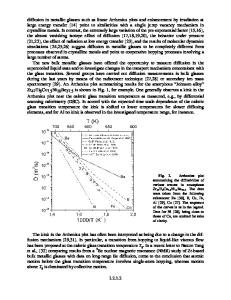Micromechanisms of Crystallization in (Fe,Co,Ni)-Zr Metallic Glasses
- PDF / 1,444,198 Bytes
- 6 Pages / 417.6 x 639 pts Page_size
- 72 Downloads / 307 Views
B.H.
Kear, B.C.
Giessen,
and M. Cohen,
editors
455
MICROMECHANISMS OF CRYSTALLIZATION IN (Fe,Co,Ni)-Zr METALLIC GLASSES
HANS-GEORG FRANKE, UWE KOSTER and HANS-WERNER SCHROEDER Abt. Chemietechnik, Universitat Dortmund D-4600 Dortmund, F.R.Germany JOHANN MULLER Institut f-Cir Werkstoffe, Ruhr-Universitat Bochum D-4630 Bochum, F.R.Germany
ABSTRACT Depending on the Zr-concentration crystallization of (Fe-,Co,Ni)-Zr glasses has been found by TEM studies to occur by primary and polymorphic crystallization, however, not by eutectic crystallization reactions. Nucleation and growth rates of these reactions have been analyzed systematically. Thermal stability as indicated by orowth as well as nucleation rates decreases with increasing Zr-content and atomic number of the late transition metal. Using this knowledge on nucleation and orowth rates conditions for designing particular microstructures by crystallization reactions can be predicted.
INTRODUCTION Whereas only very few papers have been published on the micromechanisms of crystallization in intertransition metal glasses such as (Fe,Ni,Co)-Zr [1,2], crystallization has been investigated in some detail in transition metalmetalloid glasses [3,41. In such glasses it has been shown that depending on the metalloid content crystallization can proceed by one of the followino reactions: (a) polymorphic crystallization, i.e. crystallization of the glass without any change in concentration into a supersaturated crystalline alloy or a metastable or stable crystalline compound. (b) primary crystallization of one of the stable phases. During such a reaction the amorphous phase will be enriched in one of the components until further crystallization is stopped by reaching a metastable equilibrium: In this case solute is rejected into the remaining glassy matrix which subsequently transforms by one of the other reactions. (c) eutectic crystallization, i.e. simultaneous crystallization of two crystalline phases by a discontinous reaction without any concentration difference across the reaction front; in the reaction front, however, the two components have to separate into the two phases. The use of a hypothetical diagram of the free energy for the various phases versus concentration has been found to be very useful in order to oain an overall picture of the reactions which can occur during crystallization [53. Kinetics of crystallization has been found to be controlled by crystal growth as well as nucleation. Growth rates are independent on the annealing time for eutectic and polymorphic crystallization, but in the case of primary crystallization the growth rate has been observed to be proportional to -T-,Mei indicating volume diffusion controlled particle growth[3,4].
456 As shown in a hypothetical nucleation diagram as well as in a schematic time-temperature-crystallization diagram (fig. la &b) nucleation is controlled by two modes depending on the annealing temperature C3): (a) Athermal nucleation, i.e. growth of a number N of quenched-in nuclei which depends on the cooling
Data Loading...











